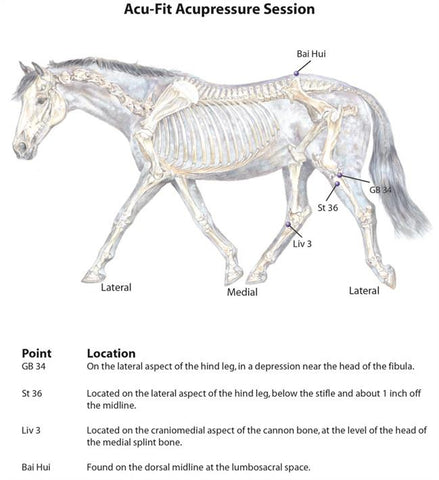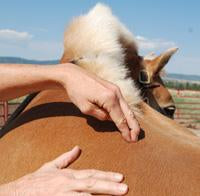By Amy Snow & Nancy Zidonis
Equine fitness requires time, thought, and action for carriage horse and owner. There’s a lot to consider in developing an effective training program in preparation for competition. Experienced professional trainers offer guidance in conditioning and equine management. There are tons of books, DVDs, plus free videos on the internet to help you along.
Every owner has to make the final decision about what is best for their horse. We all want our horses to be ‘ready, willing, and able” to perform whatever task we ask. Being realistic at each stage of conditioning and being conscious of the particular horse’s capabilities and limitations is essential to avoid sudden or repetitive injuries. Working with an experienced pro is usually helpful, however, there’s another ingredient you can add to your conditioning process.
Traditional Chinese Medicine & Horses
Equine acupressure has been used for thousands of years to optimize performance. The ancient Chinese treasured their horses because they provided military might, transportation, and support of agricultural life. Their culture and survival were dependent on the health of their horses and livestock. Traditional Chinese Medicine (TCM) evolved out of clinical observation throughout the centuries of folk medicine for humans and animals. Acupressure is based on the theories and concept underlying TCM.
Acupressure is safe, deceptively gentle, and always available. You, even as a novice, can offer your horse an acupressure session that can support your conditioning program. The intention behind an acupressure session for your horse is to nourish the body tissues needed to build strength and flexibility as well as maintaining a positive attitude for training. The acupressure session provided in this article, though not specific to your horse, can contribute to his physical and emotional well-being when added to your training regime.
How Acupressure Works
According to Chinese medicine the two most vital substances, blood and chi (also seen as qi or ki and pronounced “Chee”), must flow harmoniously though the horse so that the internal organs can function properly to nourish the entire body. Chi is life-promoting energy that supports all the body’s functions such as respiration, keeping the body warm, moving food through the digestive system, or maintaining the immune system. Blood is all the nutrient-rich fluids in the body.
Blood and chi are seen to flow along energetic pathways or channels often called “meridians.” When chi and blood become blocked due to an injury, stress, or any form of constraint it most likely leads to an internal imbalance. When there’s an imbalance the flow of chi and blood is disrupted and the horse’s body is not receiving the nourishment required to build healthy bones, muscles, tendons, and ligaments essential to the equine athlete.
Better to stay ahead of the situation by offering your horse a general acupressure session. This would help support the harmonious flow of chi and blood throughout his body.
Acupressure Session for Training
Acupressure supports training and conditioning programs by helping to maintain the flow of blood and chi to nourish the horse’s internal organs and tissues while also supporting the animal’s heart and emotional stability.
Stomach 36 (St 36), Leg Three Miles – this acupoint is known to enhance the flow of blood to the four-limbs, thus helping to build healthy muscles. Additionally, St 36 is responsible for the health of the digestive track which can be an issue during rigorous training.
Gall Bladder 34 (GB 34), Yang Mound Spring – Through clinical observation, GB 34 has proven to strengthen and enhance the flexibility of the tendons and ligaments.
Liver 3 (Liv 3), Great Thoroughfare – Liv 3 influences the harmonious flow of chi and blood throughout the horse’s body and nourishes the other internal organs.
Bai Hui, Heaven’s Gate is a classic equine acupoint that helps with emotional issues along with bringing blood and chi to the back and hindquarters which is so important for carriage horse impulsion.

Performing an Acupressure Session
A session incorporates therapeutic intent with the understanding that your connection with your horse is a dynamic energy exchange between two equal partners. It begins with selecting a location that is safe and has few distractions.
Take three deep breathes then rest one hand on your horse wherever it is comfortable. With your other hand place the soft tip of your thumb or two-fingers (see photographs) depending on what is most comfortable for you on an acupoint shown in the chart.
- Thumb technique: Place the soft tip of your thumb directly on the acupoint and hold the point gently but with intent, count to 30 before releasing each point. This technique is usually best on the body of the horse.
- Two-finger technique: Put your middle finger on top of your index finger and then place your index finger gently, but with intentional firmness, directly on the acupoint, count to 30 before releasing each point. The two-finger technique is best used on the horse’s lower limbs.

All of the acupoints on the chart are bilateral; we suggest you work with these points on both sides of your horse. Watch your horse’s reaction to the point work. Healthy energy releases are: yawning, deep breathing, muscle twitches, release of air, and softening of the eye. If your horse is overly reactive to a particular point or exhibits a pain reaction, move on to the next point. Try that point again at a later session.
When you have completed the point work give your horse a hug and allow him to rest or turn him out for at least 24 hours for his chi to circulate and replenish his body. Your horse will be “eager, willing, and able” to work with you during your next training day.

